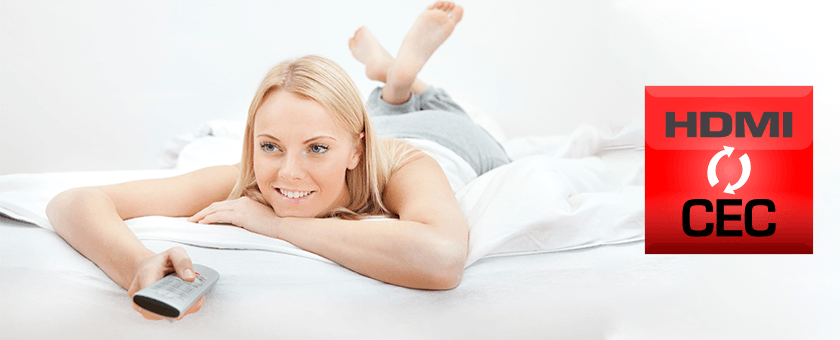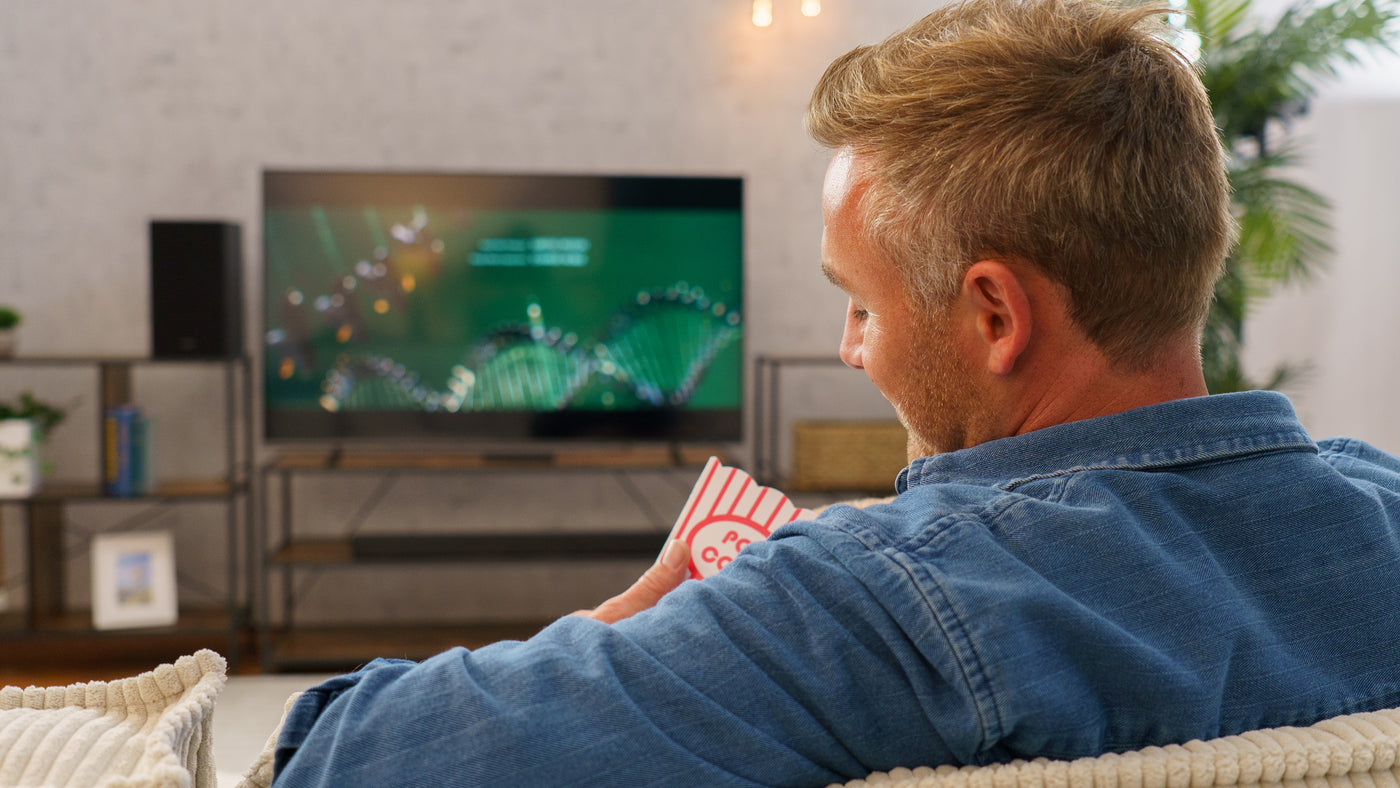HDMI can transmit not only video and audio signals, but also a wide range of other data. Devices exchange various data and commands over the network. CEC (Consumer Electronics Control) also uses an HDMI connection. The goal of CEC is to allow you to control important functions of the connected device with the TV remote control. This simplifies operation. For this to work, the connected HDMI devices must support CEC. CEC is specified for a maximum of 15 devices and one TV as an HDMI-CEC master. Some manufacturers limit CEC to 10 devices. Protocol support can vary greatly, and there are various commands. The most important are:
- Volume control, especially when using the Audio Return Channels (ARC)
- Transfer of device names
- Automatic switching on of connected devices
- One Touch Play (automatic switching to source and starting playback)
- Automatic switching to active source
- Playback controls (forward/backward, pause, play)
- System standby (all devices in standby at the same time)
- Timer control of recording devices
- Often additional functions can be configured, please have a look at the menu and manual of your TV
A practical example
For example, if you insert a Blu-ray disc into the player and start playback, the TV and sound system should automatically turn on and switch to the correct HDMI input. This usually works very well for devices from the same manufacturer and of similar years. If the implementation of CEC differs too significantly, functions are lost. Manufacturers use different names for CEC. This is partly for marketing reasons, but also to differentiate themselves from other manufacturers' functions.
HDMI-CEC from TV manufacturers
| NAME | MANUFACTURER |
|---|---|
| Anynet+ | Samsung |
| Aquos Link | Sharp |
| Bravia Link | Sony |
| DigiLink | Grundig |
| EasyLink | Philips |
| Regza Link | Toshiba |
| Simplink | LG |
| TechniLink | TechniSat |
| VieraLink | Panasonic |
During the HDMI handshake during power-on or connection, the TV exchanges information with the other HDMI devices regarding supported functions and assigns addresses for communication ( see details below ). This also works with devices connected via HDMI that are turned off. When CEC is active, the HDMI sources register with the TV. This exchange takes place via Pin 13 the HDMI connection.
Some devices or functions can only be triggered via addressed control commands. Such devices require their own address. The master device uses these addresses to send commands to specific target devices. When a master device sends a command, it is broadcast to all devices in the HDMI chain. The target device with the corresponding address will respond to the command, while the other devices will ignore it. In addition, there is also the concept of the broadcast address, which allows the master to address all devices at once, for example, to turn off all devices connected to the HDMI chain.
restrictions
Because CEC specifies a single device (typically a television) as the central element (HDMI CEC Master), it doesn't work reliably in other configurations—for example, without a television (when listening to music) or with two televisions. Therefore, HDMI splitters typically don't support control via HDMI CEC. The system isn't designed for two or more televisions. The television can also only control one of two sound systems. Because this can cause malfunctions, HDMI CEC can be disabled on the television.
This becomes clear when you delve deeper into CEC:
Important addresses and their functions
As described, HDMI-CEC allows devices to communicate and control each other via HDMI. CEC uses two types of addresses, both of which play an important role:
1. Logical address
The logical address is a number between 0 and 15. This number determines the device type:
- 0 = TV
- 5 = Audio system
- 4, 8, 11 = playback devices
- 1, 2, 9 = recording devices
- 3, 6, 7, 10 = tuners
- The other addresses (12, 13) are reserved, 14 is for free use and 15 is for unregistered or broadcast devices.
The logical address is assigned dynamically. This means that the assignment can change depending on the power-on sequence of the devices. For example, one day player A may be assigned address 4 and player B address 8. However, if the order of the devices is changed the next time the device is powered on, A will receive address 8 and B address 4. Some devices will always retain their address because they are always active on the CEC bus. If there are too many devices of one type (e.g. four playback devices), the logical addresses must be reused, which is also possible. A device receives an address by attempting to ping devices connected via HDMI. If the ping is not acknowledged, meaning the address is free, the device claims the address for itself. If the ping is acknowledged, the device tries a different address. This is often a source of errors, namely when devices are later added or removed from the HDMI chain.
2. Physical address
The physical address is based on the HDMI ports to which the device is connected. It essentially represents a path to the device and is specified as four numbers separated by periods. Here are some examples:
- 0.0.0.0 = TV
- 1.0.0.0 = 1st HDMI port on the TV
- 2.0.0.0 = 2nd HDMI port on the TV
- 2.2.0.0 = 2nd HDMI port of the TV, 2nd HDMI port of a switch
- 3.2.1.0 = 3rd HDMI port on the TV, 2nd HDMI port on the switch, 1st HDMI port on the AV receiver
This physical address specifies the exact path the signal takes on the HDMI cable to reach the destination device. A 0 means the path ends at this point. Unlike the logical address, the physical address of a device remains fixed unless the device is plugged into a different HDMI port or a device in front of it is plugged into a different HDMI port (from the TV's perspective).
Both address types work together to ensure seamless control and interaction between the connected devices.
Problems in practice
It's not uncommon for HDMI-CEC to be problematic. When using an ARC/eARC sound system, proper CEC functionality is crucial. This is because such a sound system must be controlled by the TV. Problems can also arise when using two displays, for example, with an HDMI splitter or HDMI matrix switch. As described, CEC only works correctly with a single display.
Typical errors include no audio output from the soundbar, periodic image dropouts, or no signal transmission at all between the HDMI source and HDMI sink. This happens when a new device is added or the cabling is changed. Devices are then no longer accessible using their previous logical address. Resetting the CEC addressing often helps.
To do this, proceed as follows:
- Disable HDMI-CEC on the TV (manufacturer-specific designations for CEC see above)
- If possible, delete the CEC device list on the TV (see Device Manager, Universal Device Control, Connections, etc.)
- Turn off all HDMI devices, including the TV, and unplug them from the power outlet for one minute or more.
Connect your devices via HDMI as desired. - Then plug in the power cord of the TV (or video projector) and turn it on.
- Then reactivate HDMI-CEC on the TV.
- Then plug in the power cords of your sound devices and HDMI switch, if available.
- Finally, reconnect your player to power and turn it on.
DisplayPort
DisplayPort connectors are becoming increasingly common on monitors and PC graphics cards. This connector can also be used for HDMI with a simple adapter, but it doesn't transmit CEC control . Therefore, you can't use CEC with a DisplayPort (or USB-C Alternate Mode).


